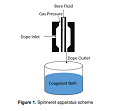Evaluation of surface modified PLLA-collagen hollow fiber as vascular graft

Downloads
Background: Cardiovascular disease as the first silent killer in the world is related to atherosclerosis plaque. Coronary artery bypass grafting as a gold standard for severe atherosclerosis needs alternative materials to replace the narrowed artery due to plaque. PLLA is one of the biodegradable polymers which is suitable for the vascular graft, but some of its weaknesses should be addressed.
Objective: The aim of this research is to improve PLLA characteristics for a vascular graft candidate by using collagen and chitosan.
Methods: This study was an experimental study that consisted of two steps, preparation of hollow fiber and evaluation of its characteristic. This research evaluated the effect of chitosan concentration against cytotoxicity and hemocompatibility using MTT assay and hemolytic test.
Results: The result showed that chitosan could improve the biological characteristics of hollow fiber PLLA-collagen, non-toxic, and non-hemolytic.
Conclusions: There is a good effect on the biological characteristics of PLLA-Collagen hollow fiber by adding chitosan on the surface of PLLA-Collagen hollow fiber.Authors retain copyright and grant the journal right of first publication with the work simultaneously licensed under a Creative Commons Attribution-NonCommercial 4.0 International License that allows others to share the work with an acknowledgement of the work's authorship and initial publication in this journal.
Authors are able to enter into separate, additional contractual arrangements for the non-exclusive distribution of the journal's published version of the work (e.g., post it to an institutional repository or publish it in a book), with an acknowledgement of its initial publication in this journal.
Authors are permitted and encouraged to post their work online (e.g., in institutional repositories or on their website) prior to and during the submission process, as it can lead to productive exchanges, as well as earlier and greater citation of published work (See The Effect of Open Access).

This work is licensed under a Creative Commons Attribution-NonCommercial 4.0 International License.











